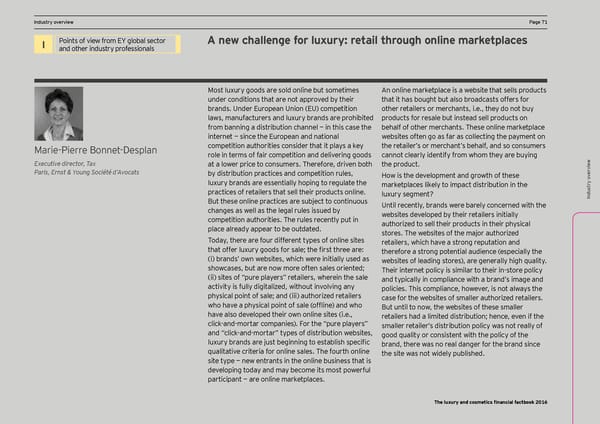DCF and vIndustry oaluation pverview arameters HPa_e /)age /) I Points of view from EY global sector A new challenge for luxury: retail through online marketplaces and other industry professionals Most luxury goods are sold online but sometimes An online marketplace is a website that sells products under conditions that are not approved by their that it has bought but also broadcasts offers for brands. Under European Union (EU) competition other retailers or merchants, i.e., they do not buy laws, manufacturers and luxury brands are prohibited products for resale but instead sell products on from banning a distribution channel — in this case the behalf of other merchants. These online marketplace internet — since the European and national websites often go as far as collecting the payment on Marie-Pierre Bonnet-Desplan competition authorities consider that it plays a key the retailer’s or merchant’s behalf, and so consumers role in terms of fair competition and delivering goods cannot clearly identify from whom they are buying w Executive director, Tax at a lower price to consumers. Therefore, driven both the product. Paris, Ernst & Young Société d’Avocats by distribution practices and competition rules, ervie How is the development and growth of these v luxury brands are essentially hoping to regulate the marketplaces likely to impact distribution in the try o practices of retailers that sell their products online. luxury segment? Indus But these online practices are subject to continuous Until recently, brands were barely concerned with the changes as well as the legal rules issued by websites developed by their retailers initially competition authorities. The rules recently put in authorized to sell their products in their physical place already appear to be outdated. stores. The websites of the major authorized Today, there are four different types of online sites retailers, which have a strong reputation and that offer lmxmrq goods for sale3 the first three are2 therefore a strong potential audience (especially the (i) brands’ own websites, which were initially used as oebsites of leading stores!, are generallq high imalitq. showcases, but are now more often sales oriented; Their internet policy is similar to their in-store policy (ii) sites of “pure players” retailers, wherein the sale and typically in compliance with a brand’s image and activity is fully digitalized, without involving any policies. This compliance, however, is not always the physical point of sale; and (iii) authorized retailers case for the websites of smaller authorized retailers. oho hane a phqsical point of sale ofÖine! and oho But until to now, the websites of these smaller have also developed their own online sites (i.e., retailers had a limited distribution; hence, even if the click-and-mortar companies). For the “pure players” smaller retailer’s distribution policy was not really of and “click-and-mortar” types of distribution websites, good imalitq or consistent oith the policq of the lmxmrq brands are bmst beginning to establish specific brand, there was no real danger for the brand since imalitatine criteria for online sales. The fourth online the site was not widely published. site type — new entrants in the online business that is developing today and may become its most powerful participant — are online marketplaces. The luxury and cosmetics financial factbook 2016
 Luxury and Cosmetic Financial Factbook Page 72 Page 74
Luxury and Cosmetic Financial Factbook Page 72 Page 74